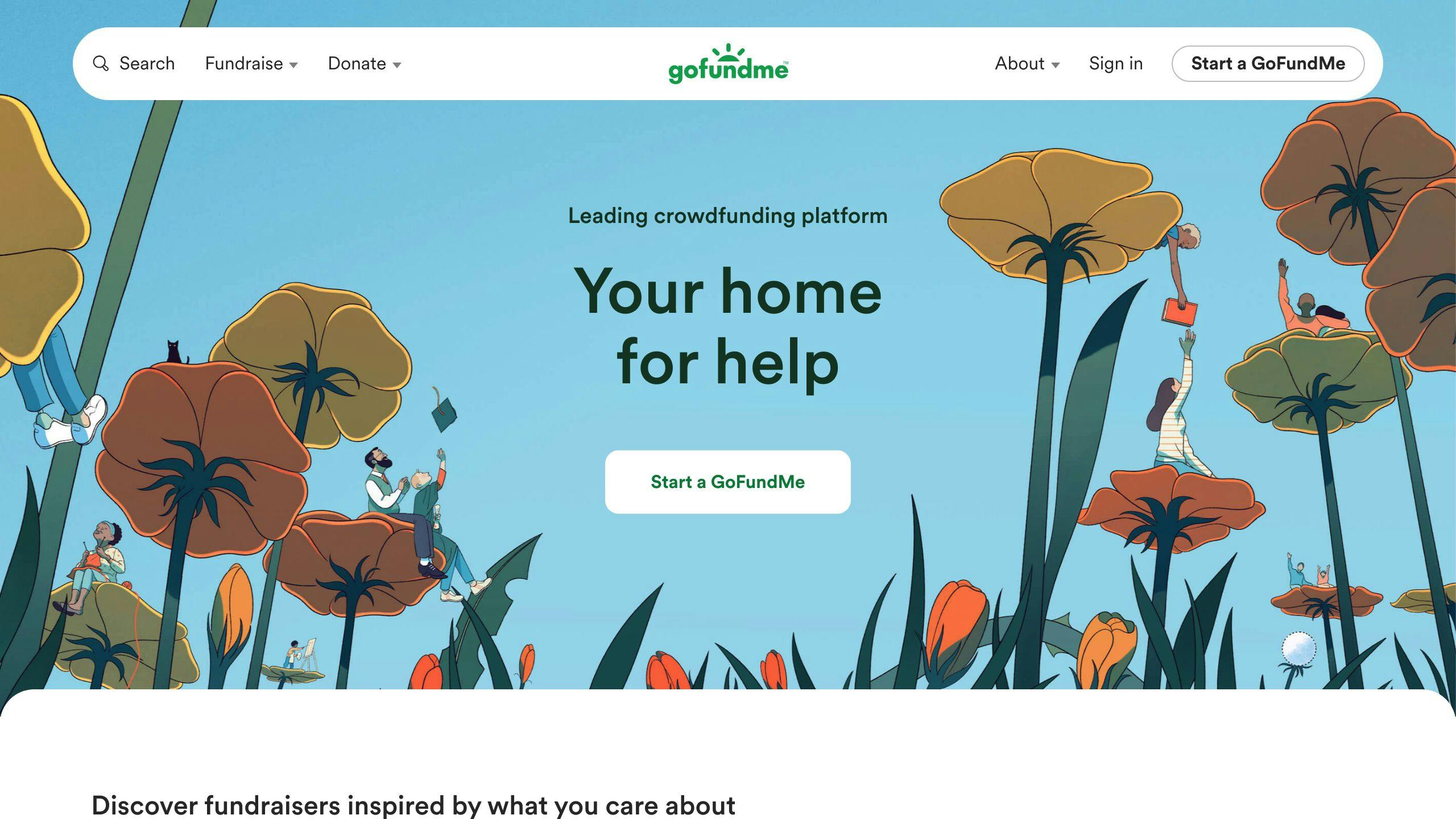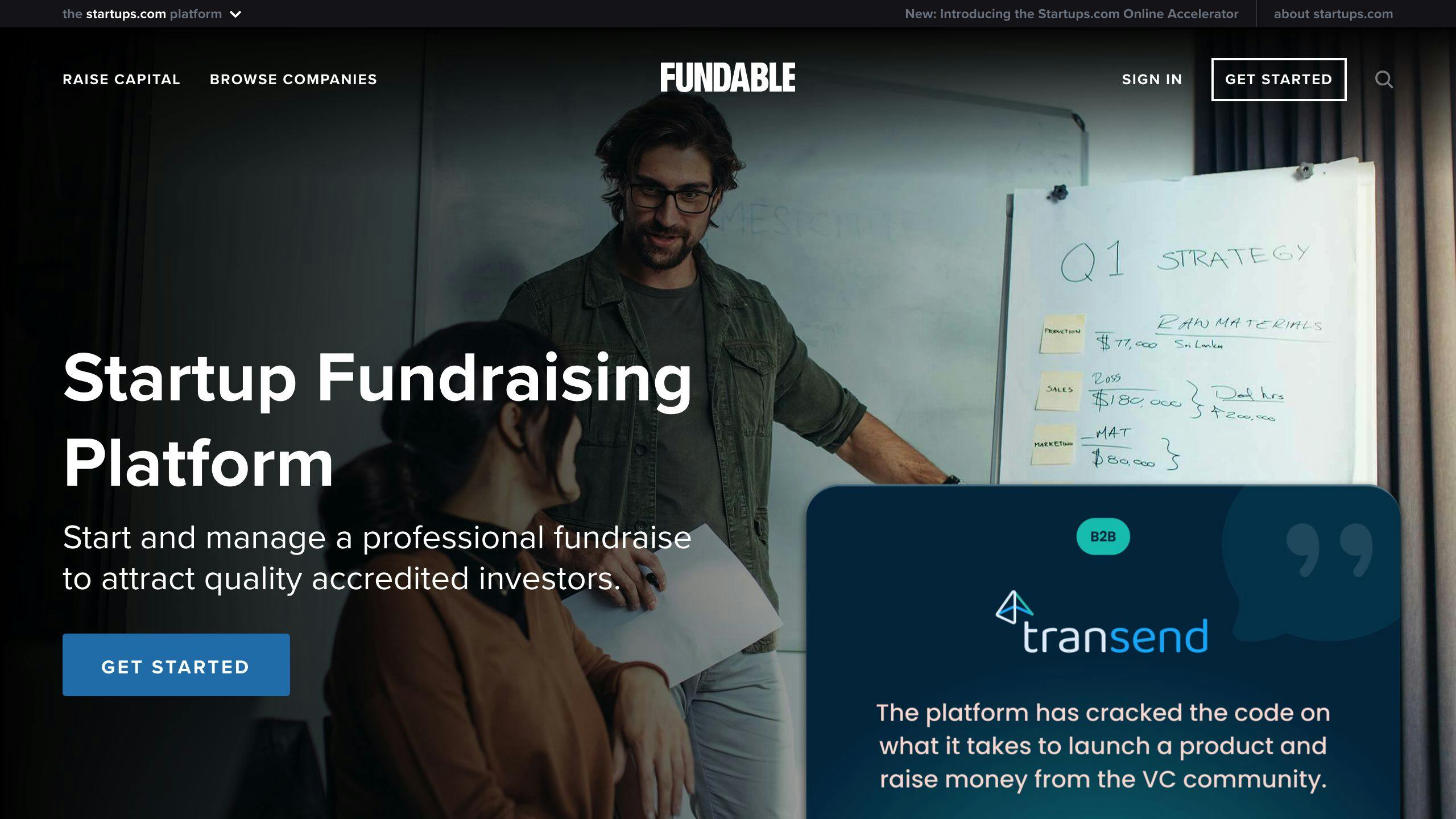Want to build trust and boost your crowdfunding success? Here's what you need to know about transparency:
- Regular updates increase donations by $65/month on average
- Platform certification processes boost donations by $22/month
- Clear communication is crucial for project creators
- Each platform has unique transparency approaches
Top 5 crowdfunding platforms and their transparency features:
- Kickstarter: "Risks and Challenges" section, all-or-nothing model
- Indiegogo: Mandatory monthly updates, flexible funding
- GoFundMe: Emphasis on personal stories, keep-what-you-raise model
- Seedrs: Strict financial regulations for equity crowdfunding
- Fundable: Thorough due diligence on campaigns
Quick Comparison:
| Platform | Funding Model | Key Transparency Feature | Best For |
|---|---|---|---|
| Kickstarter | All-or-nothing | Risks and Challenges section | Creative projects |
| Indiegogo | Flexible | Mandatory monthly updates | Various campaign types |
| GoFundMe | Keep-what-you-raise | Personal story focus | Personal causes |
| Seedrs | Equity-based | Strict financial regulations | Equity campaigns |
| Fundable | Both rewards and equity | Due diligence on campaigns | B2B and B2C startups |
Choose the right platform based on your project type, funding needs, and transparency requirements.
Related video from YouTube
1. Kickstarter

Kickstarter stands out in the crowdfunding world for its focus on transparency. The platform has built-in features that help project creators share key information with potential backers.
One of Kickstarter's most useful tools is the "Risks and Challenges" section. This mandatory part of every project page asks creators to outline:
- Potential obstacles they might face
- How they plan to overcome these hurdles
This upfront approach helps set realistic expectations and builds trust with backers.
For example, in a campaign for "The Broken Continent", the creators openly discussed cost underestimations:
"We underestimated costs involved in making the pilot through to post-production. However, we're committed to finishing the project, even if it means investing our own funds."
This honesty likely helped backers feel more confident in supporting the project.
Kickstarter also encourages creators to break down their budgets. Many successful campaigns use visual aids like pie charts to show how funds will be used:
| Budget Category | Percentage |
|---|---|
| Pre-production | 20% |
| Production | 40% |
| Post-production | 25% |
| Rewards | 10% |
| Distribution | 5% |
This level of detail helps backers understand exactly where their money is going.
To further boost credibility, Kickstarter allows creators to link to external websites. This can include:
- Personal portfolios
- Project-specific sites
- Social media profiles
These links give backers more ways to verify a creator's background and track record.
Kelley Slagle, an experienced crowdfunding author, sums up Kickstarter's approach to transparency:
"The biggest takeaway here is be honest, period."
2. Indiegogo

Indiegogo takes a different approach to transparency compared to Kickstarter. While it doesn't have a dedicated "Risks and Challenges" section, the platform emphasizes open communication between campaign owners and backers.
One of Indiegogo's key transparency features is the mandatory monthly updates for campaign owners. Failure to provide these updates can lead to account restrictions or campaign suspension. This policy helps keep backers informed about project progress and any potential setbacks.
Indiegogo's Trust & Safety team reviews Tech & Innovation campaigns at various stages:
| Stage | Description |
|---|---|
| Prototype | Early development phase |
| Manufacturing | Production process |
| Shipping | Product delivery to backers |
This review process helps inform backers about the product lifecycle and sets realistic expectations.
Unlike Kickstarter, Indiegogo offers a flexible funding model. This means projects can keep funds raised even if they don't reach their goal. While this provides more flexibility for creators, it also puts more responsibility on backers to assess project viability.
To help backers make informed decisions, Indiegogo encourages them to:
- Review the campaign's story and goals
- Check the "Updates" tab for project progress
- Conduct web searches on the campaign owner and past projects
Indiegogo provides campaign owners with tools to enhance transparency:
- Campaign Dashboard: Tracks funding progress, analyzes trends, and assesses marketing impact.
- Insights Tab: Displays total funds raised, backer numbers, and page visits.
- Referrals Dashboard: Shows traffic sources and resulting contributions.
These tools allow campaign owners to share detailed information with backers, building trust and credibility.
"Contributing to an Indiegogo campaign is not the same as making a purchase in a store; it involves supporting an idea, project, or cause."
This statement from Indiegogo highlights the importance of transparency in managing backer expectations.
While Indiegogo's approach to transparency differs from Kickstarter's, it still provides mechanisms for open communication and project tracking. The platform's focus on regular updates and detailed analytics tools helps create an environment where transparency can thrive, benefiting both creators and backers.
3. GoFundMe

GoFundMe takes a different approach to transparency compared to Kickstarter and Indiegogo, focusing on empowering fundraisers to build trust with donors through clear communication and regular updates.
The platform emphasizes the importance of providing basic information upfront. Fundraisers are encouraged to:
- Use their real name
- Clearly explain their situation
- Provide a detailed description of how funds will be used
GoFundMe's update feature plays a key role in maintaining transparency throughout the fundraising process. Successful fundraisers typically post updates at least once a week, which are automatically emailed to all subscribed donors. These updates can include:
- Photos or videos
- New information about the fundraiser's progress
- Requests for donors to share the campaign
- Thank you messages
- Encouraging words from supporters
Here's an example of an effective update message:
"Hi everyone, I want to take this opportunity to thank you all for your thoughts and donations which have made a big difference for my sick puppy. Sparky thanks you too and is feeling a bit better today after his trip to the vet earlier. He'll need to go back next week for more shots. If you can, please share our fundraiser link <link> with 3 animal lovers you know over social media, email, or text with a quick message about why you donated. Spreading the word is a huge help to us as Sparky continues to recover. More photos to come next week!"
This approach to transparency has proven effective. GoFundMe reports that fundraisers with multiple updates are more likely to meet or exceed their goals. Each update sends an email to supporters, bringing them back to the fundraiser page and reminding them of the story.
To further boost transparency, GoFundMe offers these tips to fundraisers:
| Tip | Description |
|---|---|
| Share impact | Tell donors exactly how their contributions will be used |
| Ask for feedback | Send out surveys to get donor opinions and incorporate their suggestions |
| Personalize communication | Create tailored acknowledgments and solicitations that resonate with donors |
GoFundMe also maintains a Transparency Center on its website, where it shares information about its operations, policies, and practices. This initiative aims to help users make informed decisions based on a clear understanding of how the platform works.
sbb-itb-bc761f5
4. Seedrs

Seedrs stands out in the crowdfunding landscape with its focus on equity-based campaigns and strong emphasis on transparency. The platform has developed a set of practices to ensure clear communication of project details to potential investors.
Due Diligence Process
Seedrs conducts a thorough vetting of all companies before they can raise funds on the platform. This process includes:
- Verification of company information and claims
- Assessment of the business model and financials
- Evaluation of the management team
- Analysis of market potential
Investor Communication
To keep investors informed, Seedrs encourages regular updates from companies. These updates typically cover:
- Company activities
- Performance metrics
- Milestones achieved
- Future plans
Investor Engagement
Seedrs fosters direct communication between investors and companies through:
- Online forums for investor-entrepreneur interaction
- Q&A sessions with company management
- Opportunities for investors to meet entrepreneurs in person
Voting Rights and Accountability
Investors on Seedrs receive voting rights on major corporate decisions, which helps maintain accountability. This system allows investors to have a say in:
- Significant business changes
- Key strategic decisions
- Potential exits or acquisitions
Independent Valuations
To provide unbiased assessments, Seedrs employs independent experts to value companies raising funds on the platform. This practice helps investors make informed decisions based on objective data.
Investor Education
Seedrs offers a range of educational resources to help investors understand the crowdfunding process and assess investment opportunities. These resources include:
- Guides on equity crowdfunding
- Articles on investment strategies
- Webinars on market trends
Legal Protections
Seedrs implements several legal measures to protect investors:
| Protection | Description |
|---|---|
| Nominee Structure | Seedrs acts as a collective voice for investors in shareholder voting |
| Standardized Agreements | Outlines rights and obligations of investors and businesses |
| Anti-Dilution Provisions | Protects investor stake in future funding rounds |
| Information Rights | Ensures ongoing access to company information |
Secondary Market
To address liquidity concerns, Seedrs operates a secondary market where investors can buy and sell shares in funded businesses. This feature:
- Increases investment flexibility
- Reduces long-term investment risks
- Provides potential exit opportunities for early investors
5. Fundable

Fundable takes a structured approach to project transparency, focusing on detailed disclosures and investor protection. The platform implements several key practices to ensure clear communication and accountability throughout the crowdfunding process.
Comprehensive Campaign Pages
Fundable requires campaign creators to provide in-depth information about their projects, including:
- Clear funding goals
- Detailed plans for fund utilization
- Potential risks associated with the project
This level of detail helps investors make informed decisions about their investments.
Due Diligence Process
Before approving campaigns, Fundable conducts a thorough vetting process:
| Aspect | Description |
|---|---|
| Background Check | Evaluation of campaign creator's history |
| Project Feasibility | Assessment of the project's viability |
| Financial Review | Analysis of the company's financial status |
| Market Potential | Examination of the target market and growth prospects |
Investor Education
To help investors navigate the crowdfunding landscape, Fundable offers:
- Articles on investment strategies
- Guides explaining the crowdfunding process
- Webinars on risk management in crowdfunding
These resources aim to equip investors with the knowledge needed to make sound investment choices.
Ongoing Communication
Fundable encourages regular updates from campaign creators to investors, fostering transparency throughout the funding process. This practice helps maintain trust and keeps investors informed about project progress.
Financial Safeguards
To protect investors' funds, Fundable uses escrow services. This means that:
- Funds are held securely until the campaign reaches its goal
- If a campaign fails to meet its target, funds are returned to investors
Post-Campaign Accountability
After a successful funding round, Fundable requires campaign creators to submit reports detailing:
- How funds were used
- Progress made on the project
- Any challenges encountered and steps taken to address them
This post-campaign transparency helps maintain accountability and keeps investors informed about the project's development.
Regulatory Compliance
Fundable operates under Regulation Crowdfunding, which allows companies to raise up to $5 million without SEC registration. However, this comes with strict rules:
- Companies must file a Form C with the SEC, disclosing basic information about the entity
- Annual updates are required to keep investors informed
- Investors face limits on how much they can invest based on their net worth and annual income
These regulatory measures add an extra layer of protection for investors participating in crowdfunding campaigns on Fundable.
Good and Bad Points
To help you navigate the crowdfunding landscape, let's examine the strengths and weaknesses of each platform we've discussed:
| Platform | Strengths | Weaknesses |
|---|---|---|
| Kickstarter | - Large, active community - All-or-nothing model encourages full funding - Strong brand recognition |
- No funds if goal isn't met - 5% platform fee + 3-5% processing fee - Limited to creative projects |
| Indiegogo | - Flexible funding options - Ongoing fundraising with InDemand feature - Accommodates various campaign types |
- Smaller community than Kickstarter - 5% platform fee + 3% + $0.30 processing fee - Risk of underfunding with flexible option |
| GoFundMe | - No platform fee - Keep-what-you-raise model - Quick fund access |
- 2.9% + $0.30 processing fee per donation - Not suitable for commercial projects - Less structured than other platforms |
| Seedrs | - Equity crowdfunding focus - Regulated by Financial Conduct Authority |
- 6% fee + £2,500 completion fee - Limited to equity campaigns - Potentially complex for new investors |
| Fundable | - Offers both rewards and equity funding - Supports B2B and B2C startups |
- High monthly fee of $179 - 3.5% + $0.30 transaction fee for credit cards - Extensive documentation required |
Each platform has its own approach to transparency:
Kickstarter maintains trust through its all-or-nothing model. This ensures backers only pay if the project reaches its goal. However, it doesn't guarantee project completion after funding.
Indiegogo offers both fixed and flexible funding, which can be less secure for backers. Their InDemand feature allows ongoing fundraising, but requires careful monitoring by backers.
GoFundMe focuses on personal causes, making it easier to verify campaign authenticity. However, its keep-what-you-raise model may lead to partially funded projects.
Seedrs operates under strict financial regulations, providing a high level of transparency for equity crowdfunding. This comes with added complexity and higher fees.
Fundable conducts due diligence on campaigns, enhancing trust. Their monthly fee model might deter some project creators but can lead to higher-quality campaigns.
When choosing a platform, consider these factors:
- Funding model (all-or-nothing vs. flexible)
- Fee structure
- Target audience
- Project type (creative, personal, equity, etc.)
- Transparency measures
Wrap-up
Crowdfunding transparency is key to building trust and success. Here's what we've learned:
1. Platform choice matters
Each platform has its own approach:
| Platform | Transparency Approach |
|---|---|
| Kickstarter | All-or-nothing model |
| Indiegogo | Flexible funding options |
| GoFundMe | Keep-what-you-raise model |
| Seedrs | Strict financial regulations |
| Fundable | Due diligence on campaigns |
2. Updates are powerful
Regular updates boost donations. A study of 100,000+ campaigns found that each work-related word in an update increased donations by $65 per month on average.
3. Certification helps
Platforms with certification processes saw an average increase of $22 per month in donations, showing the value of verifying campaign legitimacy.
4. Clear communication is crucial
Project creators should:
- Define goals and milestones
- Share their story and vision
- Address feedback and issues
- Show impact and gratitude
5. Platforms play a role
Crowdfunding sites should:
- Offer clear terms on payments and refunds
- Provide update/news sections
- Implement certification processes
- Ensure compliance with laws and terms of service



